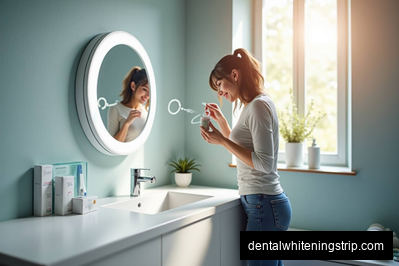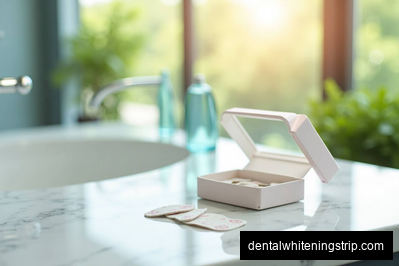Introduction
A dazzlingly white smile can be one of the most attractive features a person can have. Dental whitening strips have become an increasingly popular solution for achieving this. But have you ever wondered what makes them work? In this blog post, we'll delve into the science behind dental whitening strips and discover how they transform stained teeth into pearly whites.
In this introductory section, we delve into the importance of first impressions and how a dazzling smile can significantly enhance one's overall appearance. Beyond just aesthetics, a radiant smile can boost confidence and leave a lasting impact on those around you. Imagine confidently walking into a room, flashing a bright smile that instantly captivates everyone's attention. Dental whitening procedures are a popular choice for achieving that perfect smile, offering a quick and effective solution to brighten teeth and enhance your overall look. Understanding the power of a brilliant smile sets the stage for exploring the various ways in which dental treatments can transform not only your appearance but also your self-assurance.
The Science of Staining
Before understanding how whitening strips work, it's important to understand why teeth stain. Teeth discoloration can be caused by numerous factors, including age, genetics, certain medications, smoking, or consuming darkly pigmented foods and beverages like coffee, tea, or red wine. These substances contain color-pigmented molecules known as chromogens that attach to your teeth's enamel, causing discoloration.
Interestingly, there are two types of stains: extrinsic and intrinsic. Extrinsic stains occur on the surface of the tooth, while intrinsic stains occur within the tooth. Whitening strips are most effective at treating extrinsic stains.
The science behind staining is a fascinating journey into the intricate processes that affect our teeth. From extrinsic factors like consuming coffee and red wine to intrinsic causes such as aging and genetics, various elements contribute to tooth discoloration. Understanding the molecular changes that occur when pigmented molecules latch onto tooth enamel sheds light on why certain substances leave stubborn stains. For instance, the porous nature of enamel allows chromogens in foods and drinks to penetrate and create lasting discoloration. Delving into the science behind staining not only educates us about dental health but also empowers us to make informed choices to maintain a brighter smile.
The Chemistry of Whitening Strips
The main active ingredient in most dental whitening strips is hydrogen peroxide or carbamide peroxide. These bleaching agents penetrate the porous enamel and reach the dentin layer where they break the bonds that make up the chromogen molecules, effectively eliminating the stains.
Hydrogen peroxide, when applied to the teeth, decomposes into water and oxygen. The released oxygen molecules chemically react with the discolored molecules on the teeth, breaking them down into smaller, less pigmented components. This process is known as oxidation and is the key to dental whitening strips' effectiveness.
Beyond hydrogen peroxide and carbamide peroxide, the chemistry of whitening strips delves into the role of other key ingredients like glycerin and sodium hydroxide. Glycerin acts as a humectant, preserving moisture in the strips to prevent them from drying out, while sodium hydroxide helps adjust the p H levels for optimal whitening efficacy. Understanding these additional components is crucial for users seeking a deeper insight into how whitening strips work on a molecular level. Moreover, the interaction between these ingredients and the enamel's mineral structure is a fascinating area of study, shedding light on the intricate science behind achieving a brighter smile.
The Application and Effectiveness
Whitening strips are thin, flexible pieces of plastic coated in a layer of the whitening gel. They are designed to conform to the shape of your teeth and keep the whitening gel in direct contact with your teeth to improve the whitening process. Typically, they need to be applied once or twice a day for two weeks. The results usually last for several months.
A study published in the Journal of the American Dental Association found that whitening strips effectively lightened teeth by one to two shades on a standard dental color chart. However, it's important to note that the effectiveness of whitening strips can vary depending on the severity of the discoloration, the concentration of the peroxide in the strips, and how long and how often they are applied.
When it comes to the application of whitening strips, the key lies in precision and consistency. Properly aligning the strips with your teeth ensures even coverage and optimal contact with the whitening gel, maximizing its effectiveness. Additionally, following the recommended usage guidelines, such as avoiding eating or drinking for a period after application, can significantly enhance the results. For example, some advanced whitening strip formulas now incorporate innovative technologies like enamel-safe ingredients and non-slip adhesion properties, further improving their application and effectiveness.
The Pros and Cons
Whitening strips are a convenient and affordable option for teeth whitening. They can be used at home without the need for a dentist appointment and can provide significant results. However, there are some downsides. Some people may experience tooth sensitivity or gum irritation after using whitening strips. Also, they might not whiten all teeth evenly, especially if the teeth are crooked. Lastly, they are not effective on caps, crowns, veneers, fillings, or dentures.
One of the key pros of using whitening strips is their ease of use. Unlike professional whitening treatments that require visits to the dentist, whitening strips can be applied in the comfort of your own home at your convenience. Additionally, they are generally more affordable, making them an attractive option for those looking to enhance their smile without breaking the bank.
On the flip side, a common con of whitening strips is their potential to cause tooth sensitivity. Some individuals may experience temporary sensitivity or irritation in their gums after using whitening strips. It's important to follow the instructions carefully and consult with a dental professional if you experience any discomfort. Despite this drawback, many users find that the benefits of a brighter smile outweigh the temporary drawbacks of using whitening strips.
Conclusion
The science behind dental whitening strips is a fascinating blend of chemistry and dentistry. By understanding how they work, you can make an informed decision about whether they are the right solution for you. Always remember to use them as directed and consult your dentist if you have any concerns or experience any adverse effects.
With the right application, dental whitening strips can help you achieve that bright, white smile you've always desired, boosting your confidence and enhancing your overall appearance. So go ahead and flash those pearly whites!
In conclusion, understanding the longevity of dental whitening strips is crucial for maintaining a radiant smile. While these strips offer convenience and effectiveness, it's essential to consider the impact on tooth sensitivity over time. Consulting with a dentist can provide valuable insights on the best practices for using whitening strips safely and preserving dental health. Additionally, exploring alternative whitening methods, such as professional treatments or natural remedies, can offer a comprehensive approach to achieving and maintaining a bright smile for the long term.









